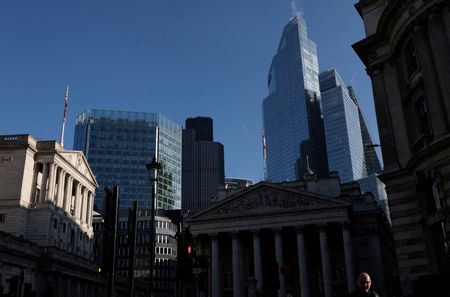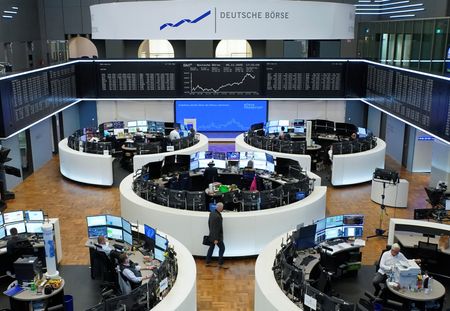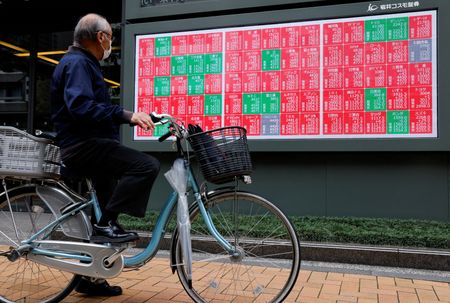By Marc Jones
LONDON (Reuters) -European shares slipped on Thursday, having uncoupled from Asia and Wall Street this week, while the pound eased away from a 7-month low as the Bank of England opted against a pre-UK budget interest rate cut.
Asia’s main markets had made solid gains overnight, [.T][.SS] some after sharp tech-led selloffs earlier this week, but in Europe and in pre-market U.S. trading those same worries were already resurfacing.
The pan-European STOXX 600 lost a modest 0.2% but French data-centre equipment firm Legrand saw its shares plunge almost 12% as it revealed just how painful US trade tariffs are proving. [.EU]
Wall Street also looked set for another subdued start with chip giant Qualcomm’s shares pointing down more than 2% after a warning that its chips might not be quite as dominant in Samsung gadgets in future as it has been used to. [.N]
Over in the currency markets, the dollar was edging back from the more-than-6-month high it had hit after upbeat U.S. data on Wednesday and as traders digested the day’s main business – the BoE’s rate decision and one in Norway.
Ahead of what are likely to be UK tax rises in UK Chancellor Rachel Reeves’ budget later this month, but also mindful of Britain’s still high headline inflation rate, the nine-strong BoE Monetary Policy Committee voted 5-4 to keep the central bank’s benchmark Bank Rate at 4.0%
That razor-thin margin kept expectations of a cut before year-end very much intact. It also kept sterling 0.3% higher on the day at $1.3090 having drooped to a 7-month low of $1.3011 on Wednesday. [GBP/] 0#GBPIRPR
“I think out of all the G7 central banks, the Bank of England is in the trickiest position,” Allspring multi-asset portfolio manager Rushabh Amin, who had expected the BoE to hold off from a cut ahead of the November 26 budget, said.
“We are a bit underweight (on sterling) into the budget,” he added, although that could be readjusted in the coming weeks. “I think the base case is just higher volatility.”
BOND MARKET MOVES
In the bond markets, gilt yields – the proxy for UK government borrowing costs – dipped fractionally to 4.47%, while those on German bunds were also down from a 4-week high at 2.67%.
U.S. Treasury yields mostly held their overnight ground as traders continued to trim bets on a Federal Reserve rate cut next month, which has pushed the dollar to a five-month peak in recent days. [/FRX]
Data on Wednesday showed the U.S. services sector activity increased to an eight-month high in October as new orders grew solidly, while private payrolls rose 42,000 last month, exceeding expectations.
“We actually are not too worried about the job market,” said Keiko Kondo, head of multi-asset investments for Asia at Schroders.
“Market is tight, companies are probably investing more in technology, probably not necessarily hiring more people, but not firing people either. So probably the way that even the economy and the labour market operate is changing a bit.”
EYE ON THE FUTURES
Wall Street futures pointed to a largely steady start there later, where investors remain focused on stretched valuations, the U.S. government shutdown, trade tariff legal rulings, and the ongoing slew of corporate earnings. [.N]
On the tariff front, U.S. Supreme Court justices raised doubts on Wednesday over the legality of President Donald Trump’s sweeping tariffs, in a case with implications for the global economy that marks a major test of Trump’s powers.
Thursday’s Qualcomm share price drop, meanwhile, comes just days after both the S&P 500 and Nasdaq logged their steepest intraday drops in close to a month on Tuesday after traders were spooked by various warnings about a likely market pullback. [.N]
Overnight, Asia had seen Japan’s Nikkei rebound 1.4% after sliding 2.5% on Wednesday, which in turn had been a follow-on from Wall Street’s drop late on Tuesday.
Hong Kong’s Hang Seng rose 2.1%. South Korea’s Kospi also jumped more than 2% after it opened but then lost traction to end a more modest 0.8% higher having tumbled 2.85% in the previous session.
In China, Shanghai’s benchmark stock index reclaimed the psychologically important 4,000 level, as optimism over tech self-sufficiency boosted its semiconductor and artificial intelligence-related shares. [.SS]
“We do see the potential broadening out of this rally,” said Daniel Blake, Morgan Stanley’s Asia and emerging markets equity strategist, referring to a rally in Chinese markets which has been led by technology companies.
Allspring’s Amin, however, said it was one of the markets the firm was thinking about taking profit on following this year’s rally.
The 10-year U.S. Treasury yield was last at 4.1473%, having risen nearly seven basis points in the previous session, while the two-year yield stood at 3.6213%.
Wednesday’s upbeat U.S. economic data releases have led to traders now pricing in a roughly 61% chance of a Fed cut in December, down from about 70% earlier in the week.
Against the yen, the dollar was down 0.3% in European trading to 153.70. The euro was up 0.2% at $1.1515 while Norway’s crown rose against both the dollar and euro after its central bank also held its interest rates steady.
In commodities, oil prices edged higher, with Brent crude futures up 0.6% at $63.95 a barrel [O/R] while gold rose 0.7%, back above $4,000 an ounce. [GOL/]
“The odds of a December Fed funds rate cut are drifting further south,” said Jose Torres, senior economist at Interactive Brokers.
(Additional reporting by Rae Wee in SingaporeEditing by Philippa Fletcher, Peter Graff)












